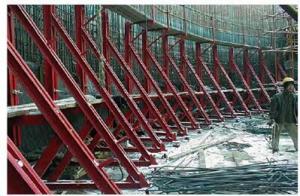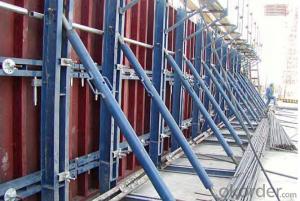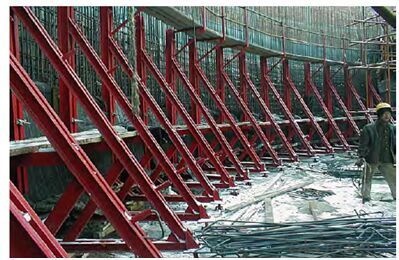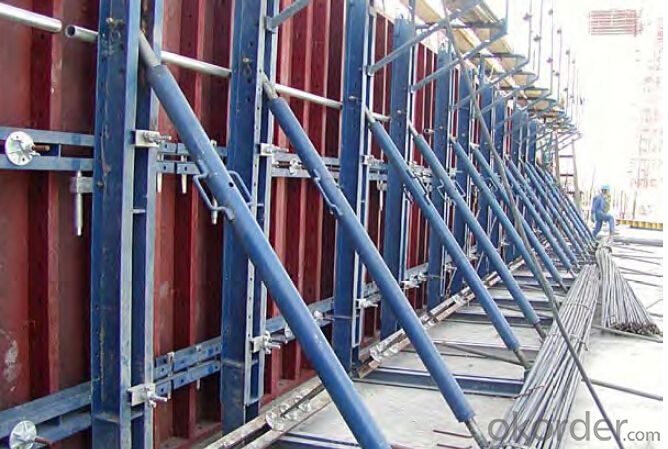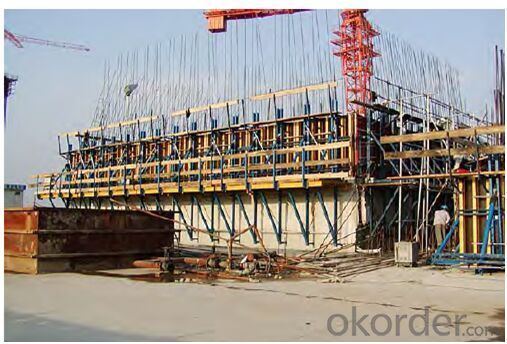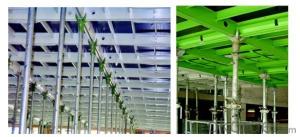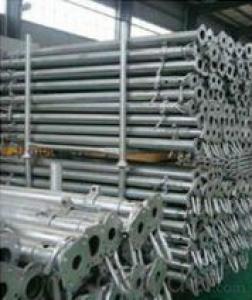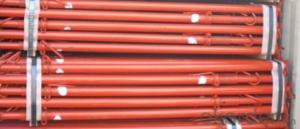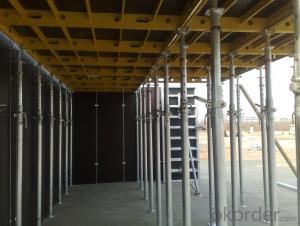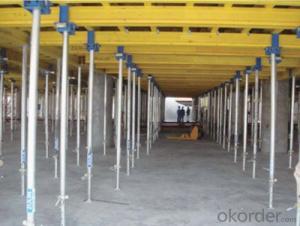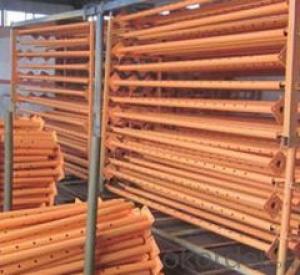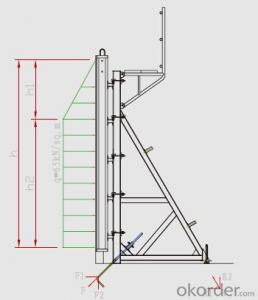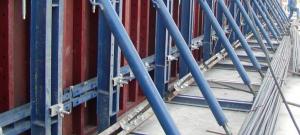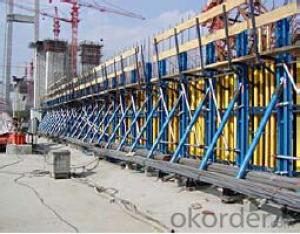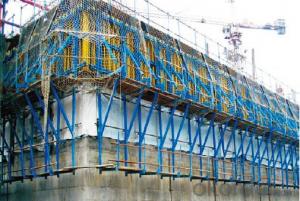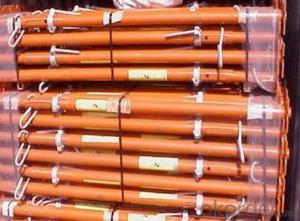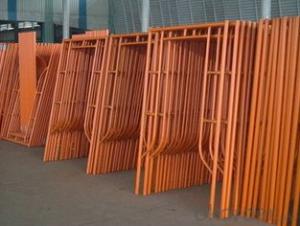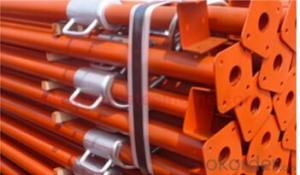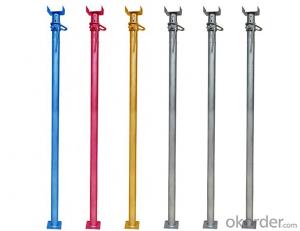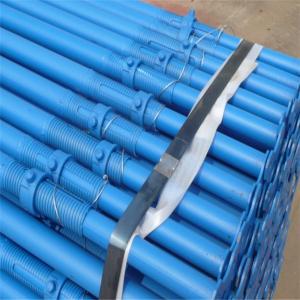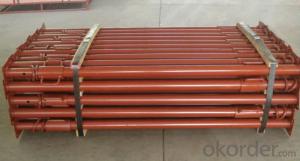Vertical Structure Support System for Single Side Bracket
- Loading Port:
- Tianjin
- Payment Terms:
- TT OR LC
- Min Order Qty:
- 200 m
- Supply Capability:
- 50000 m/month
OKorder Service Pledge
OKorder Financial Service
You Might Also Like
1. Structure of Single Side Bracket
During single-sided concreting, the concrete pressure is transferred into the sub-structure by means of the single-side bracket.
2. Main Features of Single Side Bracket
◆ For concrete heights up to 8.0m and a fresh concrete pressure up to a maximum of 60KN/m2.
◆ Good standard performance and versatility.
◆ Fast element coupling, all units can be quickly connected.
◆ The finished wall is excellent and absolutely waterproof.
◆ Optimized sizes for transportation.
3. Single Side Bracket Images
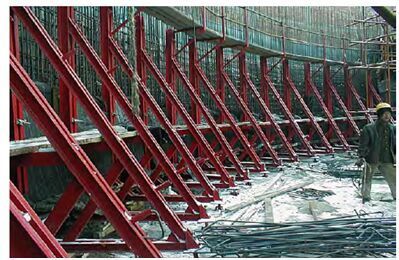
4. Single Side Bracket Specifications
There is no wall-through tie-rod in the single-side bracket system. The whole system is adjusted by the anchor system and the regulator system.
The stress situation from the sketch above.F1 can resist the side pressure of the concrete and F2 can resist the rising force. R can not only bear the gravity force of the bracket, but also the side pressure of the concrete. This stress system is simple, reasonable and also with convenience and high safety.
5. FAQ of Single Side Bracket
1) What can we do for you?
.We can ensure the quality of the Single Side Bracket and avoid extra expenses for customers.
.We can provide you the professional technical team.
.We can provide professional building proposal for your projects.
2) What promises can be done by us?
. please feel free to write us for any QUOTE.
. If need any technical and building assistance, we could provide on-site professional staff for instruction.
. Please DO check goods when courier knocks your door and contact us asap if any issueS.
3) What about of our after-sale services?
. Response will be carried out in 24hours after receiving any complain or request.
. Any formwork cost can be refund after order is confirmed.
. If the products are not based on the requirements, there will be the relevant compensations made for you.
4) What about the package and shipping time?
.Packing: wood package and adhesive tape
.Shipping: by sea
Shipping time: Normally small orders, it just1week business days to arrive your hand; When comes to the customs declaration, it may need 2weeks.
- Q: How do steel props compare to wooden shores in terms of durability?
- Compared to wooden shores, steel props exhibit higher durability. Steel, being a stronger and sturdier material than wood, renders steel props more resistant to wear and tear. They possess the capability to withstand heavy loads and provide superior support, making them appropriate for projects that demand increased strength and stability. In contrast to wood, steel is impervious to rot, decay, and termite damage, which greatly elongates its lifespan. Additionally, steel props have the added advantage of being adjustable, enabling precise height modifications to accommodate diverse construction requirements. Although wooden shores may initially be more cost-effective, steel props present a longer-lasting and more enduring solution for construction and renovation endeavors.
- Q: Why are steel braces less concrete?
- When no toughness stress will be hard, easily broken, and the concrete is flexible, a buffer force, thank you
- Q: Are steel props suitable for supporting temporary seating structures?
- Temporary seating structures can be effectively supported by steel props. These props, also known as adjustable steel props or acrow props, are widely used in construction and temporary structures to provide stability and support. Their adjustable height feature makes them versatile and adaptable for various applications, including supporting temporary seating structures. By virtue of their durable steel construction, steel props offer a robust and dependable support system. They are capable of bearing heavy loads and can be easily adjusted to the desired height, thereby facilitating flexibility when setting up temporary seating structures. Furthermore, steel props are highly practical for temporary structures due to their ease of installation and removal. They can be swiftly assembled and disassembled, saving time and effort during the setup and dismantling process. Moreover, steel props guarantee a high level of stability and safety. Equipped with sturdy base plates, they provide a solid foundation and prevent sinking into the ground. This ensures the seating structure remains stable and secure, even when accommodating a large number of people. Overall, steel props are a suitable and reliable choice for supporting temporary seating structures. Their strength, adjustability, ease of installation, and stability make them an ideal support system that can withstand heavy loads and ensure the safety and comfort of users.
- Q: Are steel props suitable for use in the construction of laboratories?
- Yes, steel props are suitable for use in the construction of laboratories. Steel props provide strong structural support and stability, making them ideal for use in laboratory construction where safety and durability are crucial. Additionally, steel props are adjustable in height, allowing for easy customization to fit the specific requirements of laboratory construction projects.
- Q: How do you ensure the stability of a steel prop on soft ground?
- To guarantee the stability of a steel prop on soft ground, there are various steps that can be taken: 1. Thoroughly evaluate the ground conditions: Before installing the steel prop, it is crucial to conduct a comprehensive assessment of the ground conditions. This involves analyzing the soil type, moisture content, and potential hazards like underground utilities or weak areas. 2. Utilize suitable foundations: To ensure stability, it is essential to employ the appropriate type of foundation for the steel prop. This may involve using concrete footings or steel plates to evenly distribute the load across the soft ground. The size and depth of the foundation will depend on project requirements and the ground's weight-bearing capacity. 3. Enhance the contact area: To minimize the risk of sinking or tilting, increasing the contact area with the ground helps distribute the load more effectively. This can be achieved by incorporating larger base plates or adding supplementary supports like timber planks or steel beams to spread the load. 4. Install additional bracing: In certain cases, additional bracing may be necessary to provide lateral support and prevent the steel prop from shifting or tilting. This can be accomplished by installing diagonal bracing or tie-backs to anchor the prop against external forces. 5. Regularly monitor and maintain: Once the steel prop is in place, it is crucial to regularly monitor its stability, especially if there are any changes in ground conditions or load-bearing requirements. This entails conducting periodic inspections, making adjustments as needed, and ensuring proper maintenance to prevent any deterioration over time. Overall, guaranteeing the stability of a steel prop on soft ground necessitates a combination of thorough assessment, appropriate foundations, increased contact area, additional bracing, and regular monitoring. By implementing these measures, the risk of instability can be minimized, ensuring the safety and effectiveness of the steel prop.
- Q: What is the typical lead time for ordering steel props?
- The typical lead time for ordering steel props can vary depending on several factors such as supplier availability, quantity requested, and shipping logistics. However, in general, it can range from a few days to a few weeks. It is recommended to contact the supplier directly for accurate and up-to-date lead time information.
- Q: How do you protect steel props from extreme weather conditions?
- To protect steel props from extreme weather conditions, there are several measures that can be taken. Firstly, applying a protective coating or paint to the steel props can help to prevent corrosion and rust caused by exposure to moisture and harsh weather elements. This coating acts as a barrier between the steel and the environment, reducing the risk of damage. Additionally, regular inspection and maintenance are crucial in ensuring the longevity of steel props. Inspecting the props for any signs of damage or wear, such as cracks or rust, allows for timely repairs or replacements to be made before the extreme weather conditions worsen the situation. When extreme weather conditions are anticipated, such as heavy rain, strong winds, or snowstorms, it is advisable to take precautionary measures. Temporary covers or shelters can be erected to shield the steel props from direct exposure to these conditions. This can be especially important during construction or renovation projects, where the props are temporarily supporting structures. Furthermore, proper storage and handling of steel props when not in use is essential. Storing them in a dry and covered area, away from direct sunlight and moisture, can help prevent damage caused by weathering. Additionally, ensuring that the props are handled and transported carefully, without any unnecessary impacts or mishandling, can further protect them from potential damage. Lastly, it is important to consider the quality and durability of the steel props themselves. Investing in high-quality props that are specifically designed to withstand extreme weather conditions can go a long way in ensuring their protection. Consulting with professionals or industry experts can provide valuable insights and guidance on selecting the most suitable and resilient steel props for specific projects. Overall, a combination of preventive measures, regular maintenance, and careful handling can help protect steel props from extreme weather conditions and extend their lifespan.
- Q: Embedded dislocation, steel support how to put? Metro Shield Construction
- Estimates also corrected the past, relatively short, only to change the location of the bolt hole.
- Q: How do you check the stability of a steel prop?
- To check the stability of a steel prop, there are a few steps that can be followed: 1. Visual inspection: Start by visually examining the steel prop for any visible signs of damage or wear. Look for any cracks, dents, or deformations. Additionally, ensure that all the components of the prop are securely fastened and in good condition. 2. Load capacity: Determine the maximum load capacity of the steel prop as specified by the manufacturer. This information is usually provided in the product manual or can be obtained from the manufacturer's website. Ensure that the load being supported by the prop does not exceed its maximum capacity. 3. Height adjustment: If the steel prop is adjustable in height, ensure that the adjustment mechanism is working properly. Check that the locking pins or screws are securely in place and capable of holding the desired height without slipping or collapsing. 4. Base stability: Assess the stability of the prop's base. Ensure that the base plate or footings are placed on a stable and level surface. If necessary, use additional support or stabilization measures, such as wedges or bracing, to prevent any movement or tipping of the prop. 5. Plumbness: Check the vertical alignment or plumbness of the steel prop. Use a spirit level or plumb bob to ensure that the prop is straight and not leaning to one side. This is important to maintain the stability of the structure being supported. 6. Load distribution: Ensure that the load being applied to the steel prop is evenly distributed across its supporting surface. Avoid concentrated loads or uneven weight distribution, as it can compromise the stability of the prop. 7. Regular maintenance: Regularly inspect and maintain the steel prop to ensure its long-term stability. This may include lubricating moving parts, tightening loose connections, and replacing any worn or damaged components. It is important to note that while these steps provide a general guideline, it is always recommended to consult the manufacturer's instructions and follow industry best practices for checking the stability of a steel prop.
- Q: Are steel props adjustable with remote control mechanisms?
- Remote control mechanisms are not typically employed for adjusting steel props. Steel props, also referred to as adjustable steel props or acrow props, are telescopic support devices utilized in construction for temporarily supporting beams, floors, and walls. They can be manually adjusted by rotating a threaded rod, allowing the prop to extend or retract to the desired height. Construction workers are responsible for on-site manual adjustment, hence remote control mechanisms are not commonly utilized in conjunction with steel props.
Send your message to us
Vertical Structure Support System for Single Side Bracket
- Loading Port:
- Tianjin
- Payment Terms:
- TT OR LC
- Min Order Qty:
- 200 m
- Supply Capability:
- 50000 m/month
OKorder Service Pledge
OKorder Financial Service
Similar products
Hot products
Hot Searches
